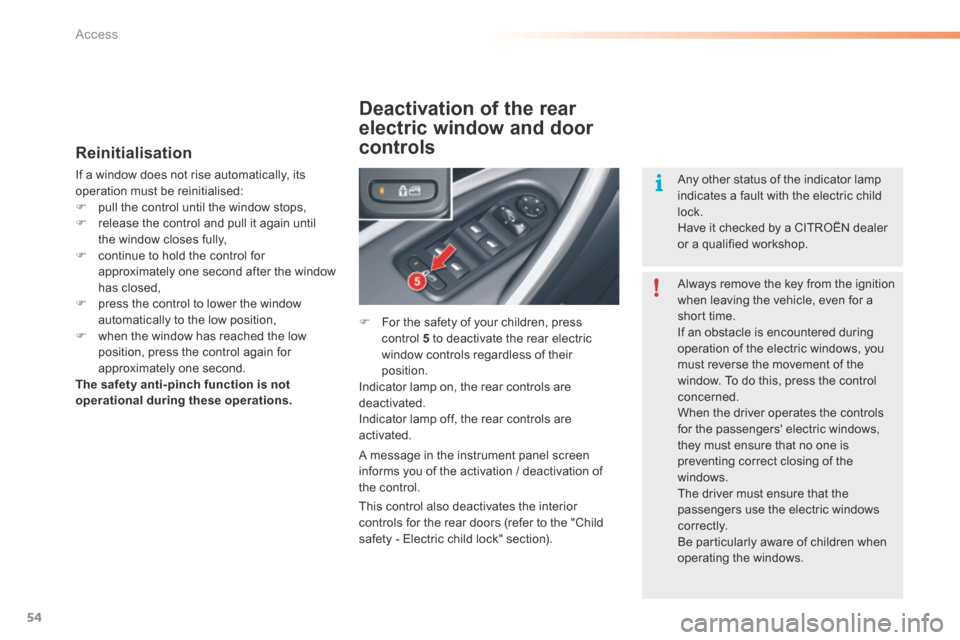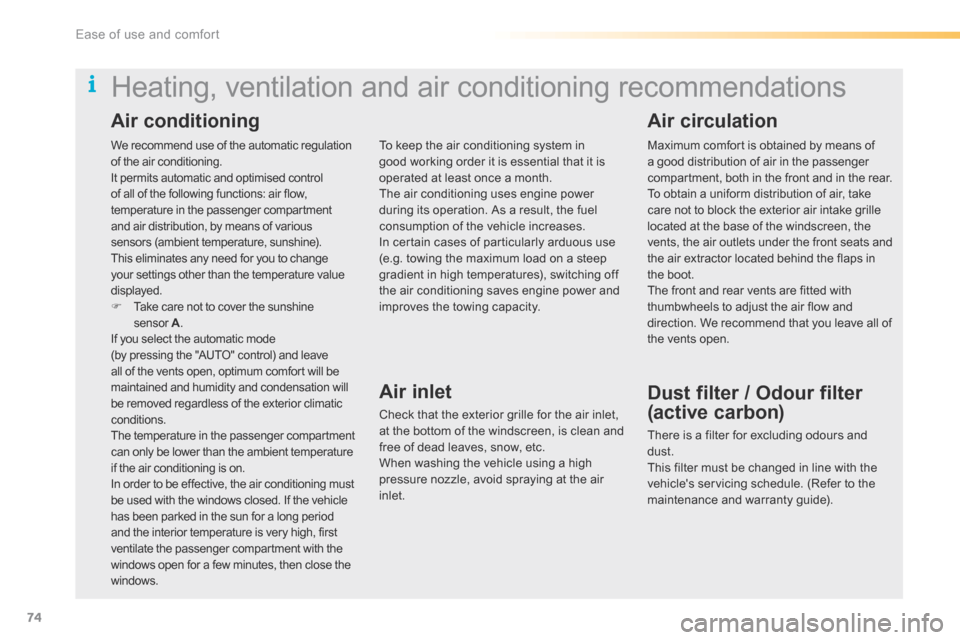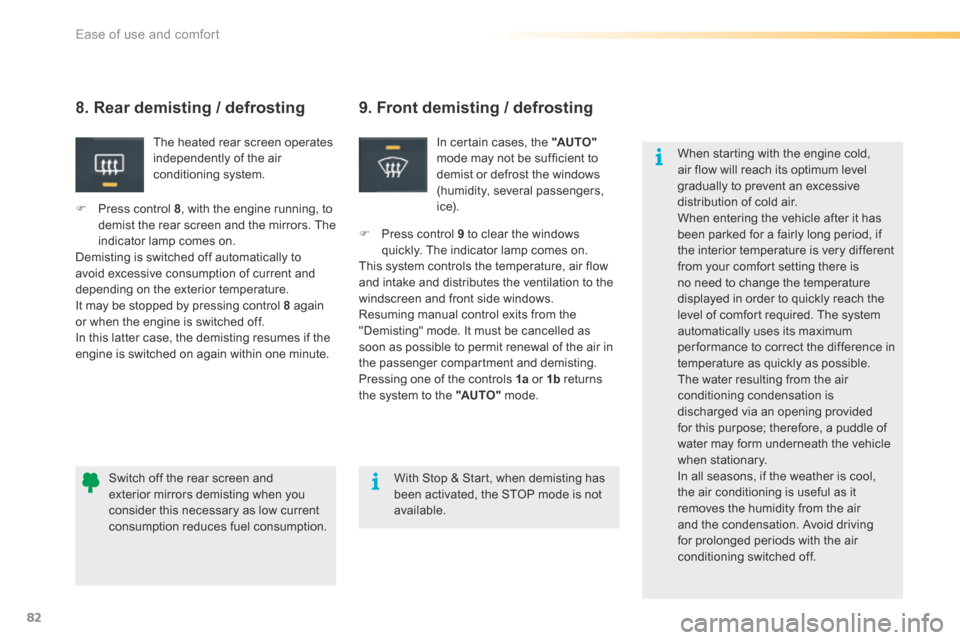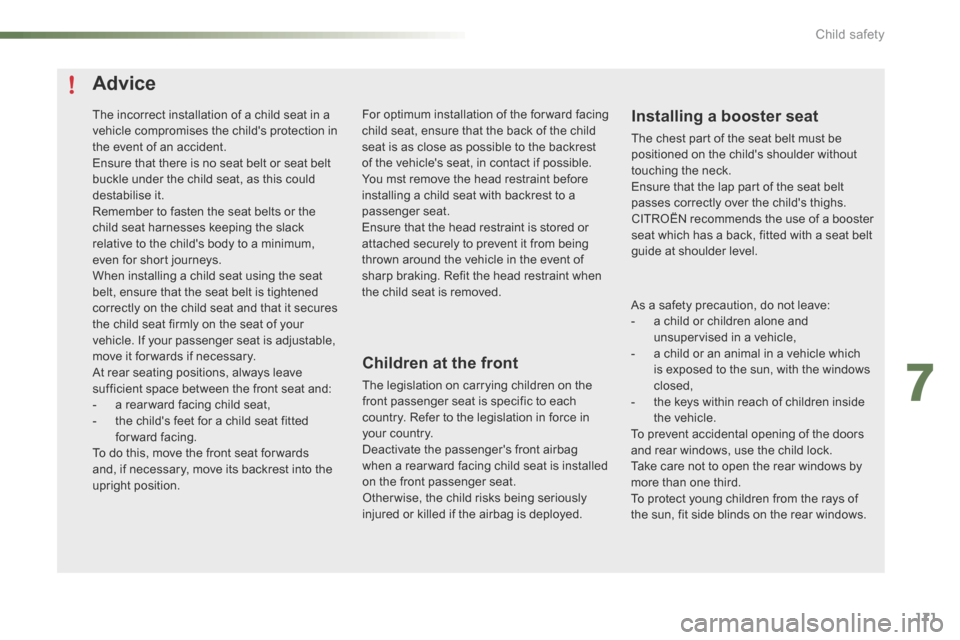window Citroen C5 2016 (RD/TD) / 2.G User Guide
[x] Cancel search | Manufacturer: CITROEN, Model Year: 2016, Model line: C5, Model: Citroen C5 2016 (RD/TD) / 2.GPages: 366, PDF Size: 30.93 MB
Page 56 of 366

54
C5_en_Chap02_ouverture_ed01-2015
Reinitialisation
If a window does not rise automatically, its
operation must be reinitialised:
F pull the control until the window stops,
F release the control and pull it again until
the window closes fully,
F continue to hold the control for
approximately one second after the window
has closed,
F press the control to lower the window
automatically to the low position,
F when the window has reached the low
position, press the control again for
approximately one second.
The safety anti-pinch function is not
operational during these operations.
Deactivation of the rear
electric window and door
controls
F For the safety of your children, press
control 5 to deactivate the rear electric
window controls regardless of their
position.
Indicator lamp on, the rear controls are
deactivated.
Indicator lamp off, the rear controls are
activated.
A message in the instrument panel screen
informs you of the activation / deactivation of
the control. Always remove the key from the ignition
when leaving the vehicle, even for a
short time.
If an obstacle is encountered during
operation of the electric windows, you
must reverse the movement of the
window. To do this, press the control
concerned.
When the driver operates the controls
for the passengers' electric windows,
they must ensure that no one is
preventing correct closing of the
windows.
The driver must ensure that the
passengers use the electric windows
c o r r e c t l y.
b
e particularly aware of children when
operating the windows.
This control also deactivates the interior
controls for the rear doors (refer to the "Child
safety - Electric child lock" section). Any other status of the indicator lamp
indicates a fault with the electric child
lock.
Have it checked by a CITROËN dealer
or a qualified workshop.
access
Page 76 of 366

74
C5_en_Chap03_ergo-et-confort_ed01-2015
We recommend use of the automatic regulation
of the air conditioning.
It permits automatic and optimised control
of all of the following functions: air flow,
temperature in the passenger compartment
and air distribution, by means of various
sensors (ambient temperature, sunshine).
This eliminates any need for you to change
your settings other than the temperature value
displayed.
F Take care not to cover the sunshine
sensor A.
If you select the automatic mode
(by pressing the "AUTO" control) and leave
all of the vents open, optimum comfort will be
maintained and humidity and condensation will
be removed regardless of the exterior climatic
conditions.
The temperature in the passenger compartment
can only be lower than the ambient temperature
if the air conditioning is on.
In order to be effective, the air conditioning must
be used with the windows closed. If the vehicle
has been parked in the sun for a long period
and the interior temperature is very high, first
ventilate the passenger compartment with the
windows open for a few minutes, then close the
windows.
Heating, ventilation and air conditioning recommendations
To keep the air conditioning system in
good working order it is essential that it is
operated at least once a month.
The air conditioning uses engine power
during its operation. As a result, the fuel
consumption of the vehicle increases.
In certain cases of particularly arduous use
(e.g. towing the maximum load on a steep
gradient in high temperatures), switching off
the air conditioning saves engine power and
improves the towing capacity.
Air inlet
Check that the exterior grille for the air inlet,
at the bottom of the windscreen, is clean and
free of dead leaves, snow, etc.
When washing the vehicle using a high
pressure nozzle, avoid spraying at the air
inlet. Maximum comfort is obtained by means of
a good distribution of air in the passenger
compartment, both in the front and in the rear.
To obtain a uniform distribution of air, take
care not to block the exterior air intake grille
located at the base of the windscreen, the
vents, the air outlets under the front seats and
the air extractor located behind the flaps in
the boot.
The front and rear vents are fitted with
thumbwheels to adjust the air flow and
direction. We recommend that you leave all of
the vents open.
Dust filter / Odour filter
(active carbon)
There is a filter for excluding odours and
dust.
This filter must be changed in line with the
vehicle's servicing schedule. (Refer to the
maintenance and warranty guide).
Air conditioning
Air circulation
Ease of use and comfort
Page 78 of 366

76
C5_en_Chap03_ergo-et-confort_ed01-2015
Control via the manual controls
It is possible to adjust one or more functions
manually, while leaving the other functions in
automatic mode.
F Press one of the controls, with the
exception of the one that regulates the
temperature 2. Indicator lamp A goes off.
Switching to manual mode may result in
discomfort (temperature, humidity, odour,
condensation) and may not provide optimum
comfort.
To return to automatic mode, press the "AUTO"
control.
3. Air distribution adjustment
F Press the controls 3 to
change the distribution of the
air flow.
4. Air conditioning
F Press control 4 . Indicator
lamp B comes on.
In order to be effective, the air conditioning
must be used with the windows closed.
Deactivating the air conditioning may result
in discomfort (temperature, humidity, odour,
condensation).
The indicator lamps corresponding to the
distribution chosen come on:
-
Windscreen and front side windows.
- Front ventilation (central and side vents
and air diffusion grille if open) and rear
ventilation.
- Front and rear footwells. The air conditioning will only operate when the
engine is running. The air blower control (air
flow adjustment) must be active to obtain air
conditioning.
Simultaneous display of the distribution of
air to the windscreen and side windows and
of front and rear ventilation is not possible.
Ease of use and comfort
Page 79 of 366

77
C5_en_Chap03_ergo-et-confort_ed01-2015
With Stop & Start, when demisting has
been activated, the STOP mode is not
available.
Switching off the ventilation
F Turn control 5 to the left until
the flow of air stops.
5. Air flow adjustment
F Turn control 5 to the right to
increase the air flow or to the
left to reduce it.
6. Front demisting / defrosting
In certain cases, the "AUTO"
mode may not be sufficient to
demist or defrost the windows
(humidity, several passengers,
i c e).
The "OFF" symbol is displayed in the display screen.
This action switches off the screen and the indicator
lamps.
It deactivates all of the system's functions, with the
exception of the rear screen demisting.
The temperature-related comfort is no longer controlled
(temperature, humidity, odour, condensation).
Avoid driving for too long with the air conditioning off.The air flow level is indicated by the
progressive illumination of the bars in the
control panel screen 9 .
To prevent condensation and deterioration
of the quality of the air in the passenger
compartment, ensure that an adequate flow of
air is maintained.
To reactivate the air conditioning:
F Press control 1 . F
Press control 6 to clear the windows
quickly. The indicator lamp comes on.
The "Demisting" mode controls the
temperature, air flow and intake and distributes
the ventilation to the windscreen and front side
windows.
Resuming manual control exits from
"Demisting" mode. It must be cancelled to
permit renewal of the air in the passenger
compartment and demisting.
Once the screen is clear, pressing control 1
returns the system to "AUTO" mode.
3
Ease of use and comfort
Page 82 of 366

80
C5_en_Chap03_ergo-et-confort_ed01-2015
2a-2b. Temperature adjustmentControl via the manual
controls3a-3b.
Air distribution
adjustment
F Press control 3b to change the distribution
of the air flow on the passenger's side.
The indicator lamps corresponding to the
distribution chosen come on:
- Windscreen and front side windows.
- Front ventilation (central and side vents
and air diffusion grille if open) and rear
ventilation.
- Front and rear footwells.
F
Turn control 2a to change the temperature
on the driver's side and control 2b
to change the temperature on the
passenger's side: to the right to increase or
to the left to reduce it.
The setting required is displayed.
The value indicated on the display corresponds
to a level of comfort and not to a temperature in
degrees Celsius or Fahrenheit, depending on
the screen configuration.
A setting around the value 21 usually provides
optimum comfort. However, depending on your
requirements, a setting between 18 and 24 is
normal. F
Press control 3a
to change the
distribution of the
air flow on the
driver's side.
F Press one of the controls, with the
exception of temperature regulation 2a and
2b . The indicator lamps A in the "AUTO"
controls go off.
It is possible to adjust one or more functions
manually while leaving the other functions in
automatic mode.
Switching to manual mode may result in discomfor t
(temperature, humidity, odour, condensation) and
may not provide optimum comfort.
To return to "AUTO" mode, press controls 1a
and 1b . The indicator lamps A come on.
On entering the vehicle, the interior
temperature may be much colder (or
warmer) than is comfortable. There
is no need to change the temperature
displayed in order to quickly obtain the
level of comfort required.
The automatic regulation of the air
conditioning will use its maximum
per formance settings to correct the
temperature difference as quickly as
possible.
Simultaneous display of the
distribution of air to the windscreen
and side windows and of front and rear
ventilation is not possible.
Ease of use and comfort
Page 83 of 366

81
C5_en_Chap03_ergo-et-confort_ed01-2015
5. Air flow adjustment
Reducing the air flow to minimum switches
the air conditioning system OFF.
To prevent condensation and deterioration
of the quality of the air in the passenger
compartment, ensure that an adequate flow of
air is maintained.
6. Air conditioning
The air conditioning will only
operate when the engine is running.
The air blower control (air flow
adjustment) must be active in order
to obtain air conditioning.
7. Intake of exterior air /
Recirculation of interior air
Automatic air intake mode
It is activated by default in
automatic comfort regulation.
Automatic mode is activated with
reverse gear or operation of the
screenwash. Closing the air intake
F
Press control 7 to close the
exterior air intake.
It must be cancelled as soon as possible to
permit renewal of the air in the passenger
compartment and demisting.
Intake of exterior air
F Press control 7 once to open
the exterior air intake.
While retaining the other settings, this position
allows the driver to isolate the passenger
compartment at any time from unpleasant
exterior odours and fumes.
F
Press the control:
- to increase the air flow,
- to reduce the air flow.
The air flow level is indicated by the
progressive illumination of the fan
blade indicator lamps.
This function permits recirculation of the air
and isolation the passenger compartment from
exterior fumes and odours. It is inactive when
the ambient temperature is below +5 °C to
avoid the risk of misting inside the vehicle.
You can store the settings of the air
conditioning system. Refer to the
"Storing driving positions" section.
F
Press control 6 . The indicator lamp comes
on.
In order to be effective, the air conditioning
must be used with the windows closed.
3
Ease of use and comfort
Page 84 of 366

82
C5_en_Chap03_ergo-et-confort_ed01-2015
9. Front demisting / defrosting
In certain cases, the "AUTO"
mode may not be sufficient to
demist or defrost the windows
(humidity, several passengers,
i c e).
8. Rear demisting / defrosting
The heated rear screen operates
independently of the air
conditioning system.
F Press control 8 , with the engine running, to
demist the rear screen and the mirrors. The
indicator lamp comes on.
Demisting is switched off automatically to
avoid excessive consumption of current and
depending on the exterior temperature.
It may be stopped by pressing control 8 again
or when the engine is switched off.
In this latter case, the demisting resumes if the
engine is switched on again within one minute. F
Press control 9 to clear the windows
quickly. The indicator lamp comes on.
This system controls the temperature, air flow
and intake and distributes the ventilation to the
windscreen and front side windows.
Resuming manual control exits from the
"Demisting" mode. It must be cancelled as
soon as possible to permit renewal of the air in
the passenger compartment and demisting.
Pressing one of the controls 1a or 1b returns
the system to the "AUTO" mode.
With Stop & Start, when demisting has
been activated, the STOP mode is not
available. When starting with the engine cold,
air flow will reach its optimum level
gradually to prevent an excessive
distribution of cold air.
When entering the vehicle after it has
been parked for a fairly long period, if
the interior temperature is very different
from your comfort setting there is
no need to change the temperature
displayed in order to quickly reach the
level of comfort required. The system
automatically uses its maximum
per formance to correct the difference in
temperature as quickly as possible.
The water resulting from the air
conditioning condensation is
discharged via an opening provided
for this purpose; therefore, a puddle of
water may form underneath the vehicle
when stationary.
In all seasons, if the weather is cool,
the air conditioning is useful as it
removes the humidity from the air
and the condensation. Avoid driving
for prolonged periods with the air
conditioning switched off.
Switch off the rear screen and
exterior mirrors demisting when you
consider this necessary as low current
consumption reduces fuel consumption.
Ease of use and comfort
Page 88 of 366

86
C5_en_Chap03_ergo-et-confort_ed01-2015
Sun visor
F With the ignition on, lift the flap; the mirror
is illuminated automatically.
To prevent dazzle from ahead, fold the visor
downwards.
It can be disengaged from its central fixing and
pivoted over to the side windows if required.
Cooled glove box
F To open the glove box, pull the handle and
lower the lid.
It has automatic illumination.
The glove box has an air vent A that can be
closed manually.
It provides access to the passenger's front
airbag deactivation switch B .
The glove box should be kept closed
when driving.
Front fittings
F Pull the grip towards you to open it.
Driver's storage compartment
Ease of use and comfort
Page 162 of 366

160
C5_en_Chap06_securite_ed01-2015
Operating fault
If this symbol is displayed in
the instrument panel screen,
accompanied by an audible signal
and a message, contact a CITROËN
dealer or a qualified workshop to
have the system checked. The
airbags may no longer be deployed in
the event of a serious impact.
In the event of a minor impact or bump
on the side of the vehicle or if the
vehicle rolls over, the airbags may not
be deployed.
No lateral airbag is deployed in the
event of a rear or front collision.
Curtain airbags*
System which contributes towards the
protection of the the driver and passengers
(with the exception of the rear centre
passenger) in the event of a serious side
impact, in order to limit the risk of injury to the
side of the head.
Each curtain airbag is fitted in the pillars and
the upper part of the passenger compartment.
Deployment
It is deployed at the same time as the
corresponding lateral airbag in the event of a
serious side impact to all or part of the side
impact zone B, perpendicular to the longitudinal
centreline of the vehicle on a horizontal plane
and directed from the outside towards the
inside of the vehicle.
The curtain airbag inflates between the front or
rear occupant of the vehicle and the windows.
* Depending on the country of sale.
Safety
Page 173 of 366

171
C5_en_Chap07_securite-enfant_ed01-2015
Advice
Children at the front
The legislation on carrying children on the
front passenger seat is specific to each
country. Refer to the legislation in force in
your country.
Deactivate the passenger's front airbag
when a rear ward facing child seat is installed
on the front passenger seat.
Otherwise, the child risks being seriously
injured or killed if the airbag is deployed.
Installing a booster seat
The chest part of the seat belt must be
positioned on the child's shoulder without
touching the neck.
Ensure that the lap part of the seat belt
passes correctly over the child's thighs.
CITROËN recommends the use of a booster
seat which has a back, fitted with a seat belt
guide at shoulder level.
The incorrect installation of a child seat in a
vehicle compromises the child's protection in
the event of an accident.
Ensure that there is no seat belt or seat belt
buckle under the child seat, as this could
destabilise it.
Remember to fasten the seat belts or the
child seat harnesses keeping the slack
relative to the child's body to a minimum,
even for short journeys.
When installing a child seat using the seat
belt, ensure that the seat belt is tightened
correctly on the child seat and that it secures
the child seat firmly on the seat of your
vehicle. If your passenger seat is adjustable,
move it for wards if necessary.
At rear seating positions, always leave
sufficient space between the front seat and:
-
a rear ward facing child seat,
- the child's feet for a child seat fitted
forward facing.
To do this, move the front seat for wards
and, if necessary, move its backrest into the
upright position. For optimum installation of the forward facing
child seat, ensure that the back of the child
seat is as close as possible to the backrest
of the vehicle's seat, in contact if possible.
You mst remove the head restraint before
installing a child seat with backrest to a
passenger seat.
Ensure that the head restraint is stored or
attached securely to prevent it from being
thrown around the vehicle in the event of
sharp braking. Refit the head restraint when
the child seat is removed.
As a safety precaution, do not leave:
- a child or children alone and
unsupervised in a vehicle,
- a child or an animal in a vehicle which
is exposed to the sun, with the windows
closed,
- the keys within reach of children inside
the vehicle.
To prevent accidental opening of the doors
and rear windows, use the child lock.
Take care not to open the rear windows by
more than one third.
To protect young children from the rays of
the sun, fit side blinds on the rear windows.
7
Child safety